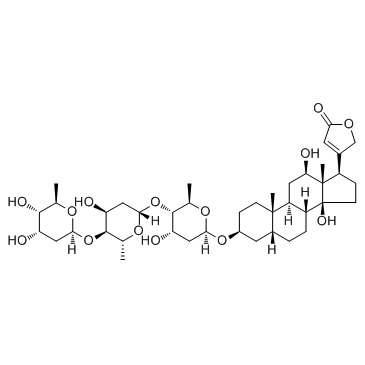digoxin

digoxin structure
|
Common Name | digoxin | ||
|---|---|---|---|---|
| CAS Number | 20830-75-5 | Molecular Weight | 780.938 | |
| Density | 1.4±0.1 g/cm3 | Boiling Point | 931.6±65.0 °C at 760 mmHg | |
| Molecular Formula | C41H64O14 | Melting Point | 248-250ºC | |
| MSDS | Chinese USA | Flash Point | 278.5±27.8 °C | |
| Symbol |



GHS02, GHS06, GHS08 |
Signal Word | Danger | |
|
Rapid detection of convallatoxin using five digoxin immunoassays.
Clin. Toxicol. (Phila.) 52(7) , 659-63, (2014) Cardiac glycosides of plant origin are implicated in toxic ingestions that may result in hospitalization and are potentially lethal. The utility of commonly available digoxin serum assays for detecting foxglove and oleander ingestion has been demonstrated, bu... |
|
|
Effects of intestinal microbiota on the bioavailability of geniposide in rats.
J. Agric. Food Chem. 62(40) , 9632-6, (2014) This study investigated the effects of intestinal microbiota on the metabolism of geniposide by using a rat model treated with a mixture of antibiotics. The plasma concentration of geniposide was determined after oral administration in control and antibiotics... |
|
|
Mechanism of an unusual, but clinically significant, digoxin-bupropion drug interaction.
Biopharm. Drug Dispos. 35(5) , 253-63, (2014) An unusual, but clinically significant, digoxin (DIG)-bupropion (BUP) drug interaction (DDI), in which BUP increased DIG renal clearance by 80% is reported. To investigate the mechanism(s) of this unusual DDI, first the effect of BUP, its circulating metaboli... |
|
|
Pharmacokinetic comparison to determine the mechanisms underlying the differential efficacies of cationic diamidines against first- and second-stage human African trypanosomiasis.
Antimicrob. Agents Chemother. 58(7) , 4064-74, (2014) Human African trypanosomiasis (HAT), a neglected tropical disease, is fatal without treatment. Pentamidine, a cationic diamidine, has been used to treat first-stage (hemolymphatic) HAT since the 1940s, but it is ineffective against second-stage (meningoenceph... |
|
|
Study on the pharmacokinetics profiles of polyphyllin I and its bioavailability enhancement through co-administration with P-glycoprotein inhibitors by LC-MS/MS method.
J. Pharm. Biomed. Anal. 107 , 119-24, (2015) Polyphyllin I (PPI), one of the steroidal saponins in Paris polyphylla, is a promising natural anticancer candidate. Although the anticancer activity of PPI has been well demonstrated, information regarding the pharmacokinetics and bioavailability is limited.... |
|
|
Digoxin and adenosine triphosphate enhance the functional properties of tissue-engineered cartilage.
Tissue Eng. Part A 21(5-6) , 884-94, (2015) Toward developing engineered cartilage for the treatment of cartilage defects, achieving relevant functional properties before implantation remains a significant challenge. Various chemical and mechanical stimuli have been used to enhance the functional prope... |
|
|
Restriction of IL-22-producing T cell responses and differential regulation of regulatory T cell compartments by zinc finger transcription factor Ikaros.
J. Immunol. 193(8) , 3934-46, (2014) Proper immune responses are needed to control pathogen infection at mucosal surfaces. IL-22-producing CD4(+) T cells play an important role in controlling bacterial infection in the gut; however, transcriptional regulation of these cells remains elusive. In t... |
|
|
Biorelevant media resistant co-culture model mimicking permeability of human intestine.
Int. J. Pharm. 481(1-2) , 27-36, (2015) Cell culture models are currently used to predict absorption pattern of new compounds and formulations in the human gastro-intestinal tract (GIT). One major drawback is the lack of relevant apical incubation fluids allowing mimicking luminal conditions in the... |
|
|
Molecular cloning and functional characterization of a rainbow trout liver Oatp.
Toxicol. Appl. Pharmacol. 280(3) , 534-42, (2014) Cyanobacterial blooms have an impact on the aquatic ecosystem due to the production of toxins (e.g. microcystins, MCs), which constrain fish health or even cause fish death. However the toxicokinetics of the most abundant toxin, microcystin-LR (MC-LR), are no... |
|
|
Impact of P-glycoprotein on blood-retinal barrier permeability: comparison of blood-aqueous humor and blood-brain barrier using mdr1a knockout rats.
Invest. Ophthalmol. Vis. Sci. 55(7) , 4650-8, (2014) The purpose of this study was to clarify the impact of P-glycoprotein (P-gp) on blood-retinal barrier (BRB) and blood-aqueous humor barrier (BAB) permeability, in contrast to blood-brain barrier (BBB) permeability.Permeabilities of six compounds, including P-... |